Directly under the Arctic Circle! Marianne's Arctic Xpress in Tromsø offers fjord, whale and wildlife tours by day, aurora tours by night. Book Now and get a 10% discount on combo day and night adventures. | | | GEOMAGNETIC STORM IN PROGRESS: Arriving earlier than expected, a stream of high-speed solar wind has engulfed Earth's magnetic field on Sept. 27th. The result is a G2-class geomagnetic storm, in progress. High-latitude sky watchers should be alert for auroras after nightfall. This is a broad stream and it could affect Earth's space environment for the next 2 to 3 days. Free: Aurora Alerts The leading edge of the stream produced an outburst of auroras over Greenland on Sept. 26th: 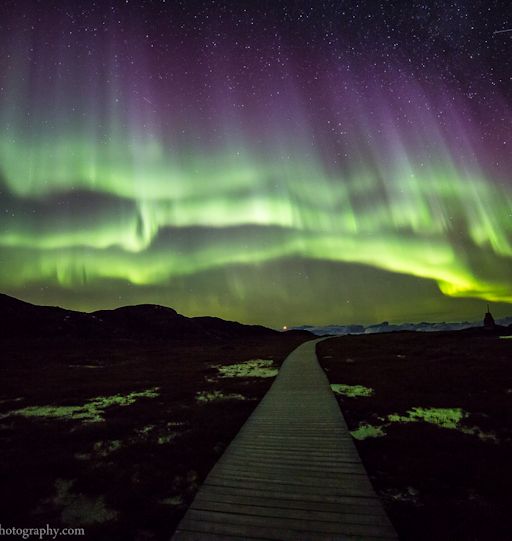
"What a night in Ilulissat, Greenland," says photographer Rayann Elzein. " These were some of the best auroras that I have ever seen! I dont see how this show could be outperformed. Well, let's wait and find out tonight!" Realtime Aurora Photo Gallery A POLAR BEAR AT THE EDGE OF SPACE. For the past year and a half, Spaceweather.com and the students of Earth to Sky Calculus have been monitoring cosmic rays in the atmosphere using high-altitude helium balloons. Their latest flight on Sept. 17th was sponsored by this bear: 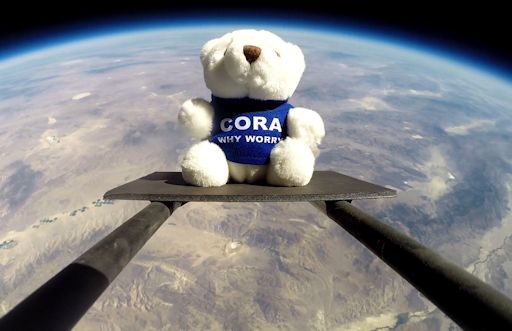
Allow us to introduce you to Cora, the mascot of Cora Refining, a small company refining precious metals for the dental industry since 1976. Their generous donation of $750 paid for all the supplies necessary to launch our radiation sensors to the stratosphere. Those Sept. 17th data have just been added to the "Cosmic Rays in the Atmosphere" section of Spaceweather.com, below. Thanks, Cora! Readers, if you would like to contribute to our growing body of knowledge about atmospheric radiation and see your mascot, photo or logo at the edge of space, please contact Dr. Tony Phillips to sponsor a flight. Sponsorships are currently available for flights scheduled on Oct. 7th, Oct. 18th, and Oct. 27th. THE STRANGE THING ABOUT THIS SUNSET.... Yesterday at sunset, Mila Zinkova was looking west from Pacifica CA when "something strange happened," she reports. The sun split into multiple layers and a green flash appeared. But, that wasn't the strange thing. Temperature inversions above the ocean surface frequently distort the setting sun off the Califonia coast. "Take a closer look at the picture," urges Zinkova. "Where did that vertical pillar of light at the bottom come from?" Scroll down for the answer: 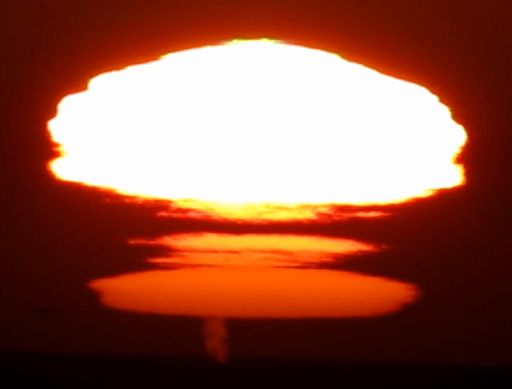
"It's the spout of a whale," she explains. In the complete video she recorded, multiple spouts can be seen grazing the bottom of the miraged sun. "Of course the sunset was unusual not because of whales, but because of some very complex temperature inversions in the atmosphere. While the lowest sun was setting, producing green flashes, the upper suns were not in a hurry to leave. They kept disappearing and reappearing." Just another evening on the California coast.... Turn up the volume and watch it again. Realtime Space Weather Photo Gallery
Realtime Sprite Photo Gallery
| | Cosmic Rays in the Atmosphere |
Updated: Sept. 26, 2016 // Next Flight: Oct. 1, 2016
Sept. 20, 2016: Readers, thank you for your patience while we continue to develop this new section of Spaceweather.com. We've been working to streamline our data reduction, allowing us to post results from balloon flights much more rapidly, and we have developed a new data product, shown here: 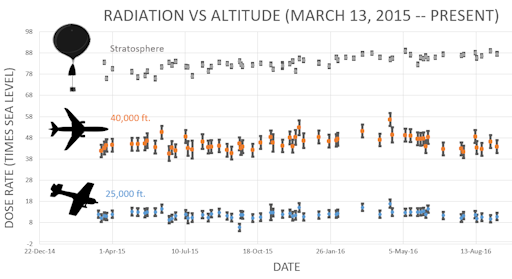
This plot displays radiation measurements not only in the stratosphere, but also at aviation altitudes. Dose rates are expessed as multiples of sea level. For instance, we see that boarding a plane that flies at 25,000 feet exposes passengers to dose rates ~10x higher than sea level. At 40,000 feet, the multiplier is closer to 50x. These measurements are made by our usual cosmic ray payload as it passes through aviation altitudes en route to the stratosphere over California. What is this all about? Approximately once a week, Spaceweather.com and the students of Earth to Sky Calculus fly space weather balloons to the stratosphere over California. These balloons are equipped with radiation sensors that detect cosmic rays, a surprisingly "down to Earth" form of space weather. Cosmic rays can seed clouds, trigger lightning, and penetrate commercial airplanes. Furthermore, there are studies ( #1, #2, #3, #4) linking cosmic rays with cardiac arrhythmias and sudden cardiac death in the general population. Our latest measurements show that cosmic rays are intensifying, with an increase of more than 12% since 2015: 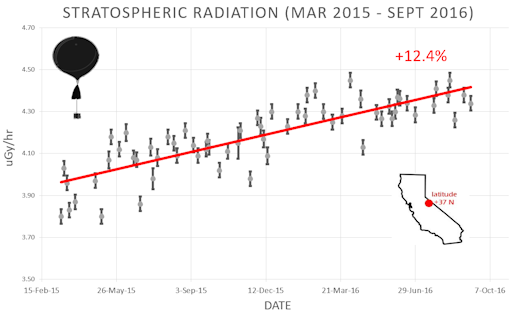
Why are cosmic rays intensifying? The main reason is the sun. Solar storm clouds such as coronal mass ejections (CMEs) sweep aside cosmic rays when they pass by Earth. During Solar Maximum, CMEs are abundant and cosmic rays are held at bay. Now, however, the solar cycle is swinging toward Solar Minimum, allowing cosmic rays to return. Another reason could be the weakening of Earth's magnetic field, which helps protect us from deep-space radiation. The radiation sensors onboard our helium balloons detect X-rays and gamma-rays in the energy range 10 keV to 20 MeV. These energies span the range of medical X-ray machines and airport security scanners. The data points in the graph above correspond to the peak of the Reneger-Pfotzer maximum, which lies about 67,000 feet above central California. When cosmic rays crash into Earth's atmosphere, they produce a spray of secondary particles that is most intense at the entrance to the stratosphere. Physicists Eric Reneger and Georg Pfotzer discovered the maximum using balloons in the 1930s and it is what we are measuring today. Every night, a network of NASA all-sky cameras scans the skies above the United States for meteoritic fireballs. Automated software maintained by NASA's Meteoroid Environment Office calculates their orbits, velocity, penetration depth in Earth's atmosphere and many other characteristics. Daily results are presented here on Spaceweather.com. On Sep. 27, 2016, the network reported 37 fireballs.
(37 sporadics)  In this diagram of the inner solar system, all of the fireball orbits intersect at a single point--Earth. The orbits are color-coded by velocity, from slow (red) to fast (blue). [Larger image] [movies] Potentially Hazardous Asteroids ( PHAs) are space rocks larger than approximately 100m that can come closer to Earth than 0.05 AU. None of the known PHAs is on a collision course with our planet, although astronomers are finding new ones all the time. On September 27, 2016 there were potentially hazardous asteroids. Notes: LD means "Lunar Distance." 1 LD = 384,401 km, the distance between Earth and the Moon. 1 LD also equals 0.00256 AU. MAG is the visual magnitude of the asteroid on the date of closest approach. | | The official U.S. government space weather bureau | | | The first place to look for information about sundogs, pillars, rainbows and related phenomena. | | | Researchers call it a "Hubble for the sun." SDO is the most advanced solar observatory ever. | | | 3D views of the sun from NASA's Solar and Terrestrial Relations Observatory | | | Realtime and archival images of the Sun from SOHO. | | | from the NOAA Space Environment Center | | | a proud supporter of science education and Spaceweather.com | | | the underlying science of space weather |  | Find homes for sale in Ocala, Orlando and Tampa with the #1 real estate company in Central Florida Local Realty Service |  | Claim your tax refund with this UK tax rebate company and get back your overpaid tax. |  | Enjoy this fabulous range of leather sofas from a leader in the UK sofa manufacturer industry.. | | | These links help Spaceweather.com stay online. Thank you to our supporters! | | 
